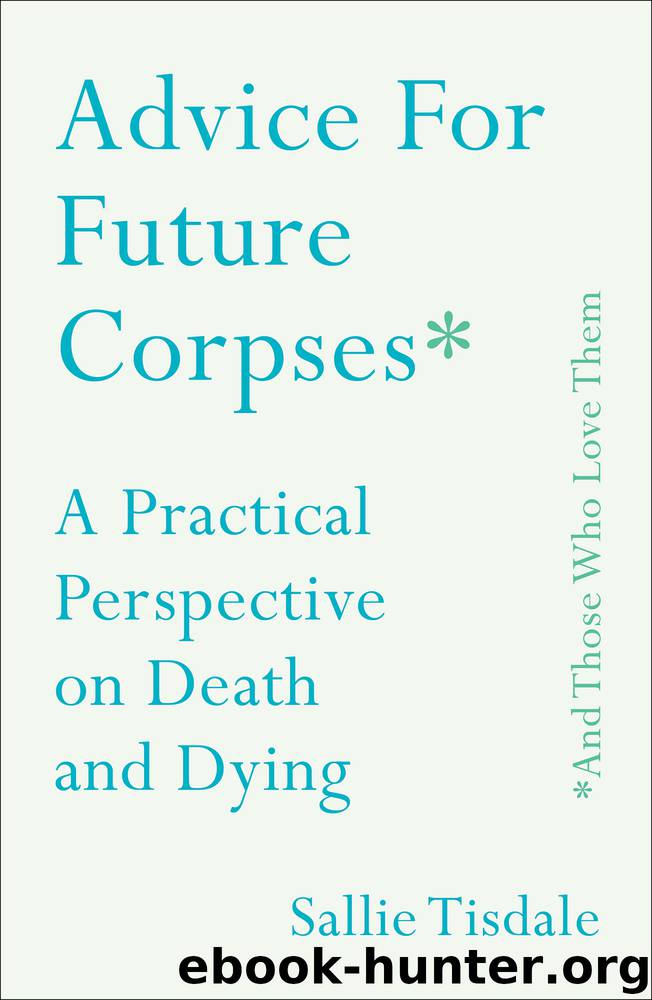Advice for Future Corpses (and Those Who Love Them) by Sallie Tisdale

Author:Sallie Tisdale
Language: eng
Format: epub
Publisher: Touchstone
8
* * *
Last Days
Not long after Butch settled into his hospital bed in our living room, he began to slide away. His sobriety had been important to him. He’d been reluctant to use narcotics, but he eventually took small doses of morphine. He could not control his bladder or bowels. He didn’t want to eat. This man who had spent most of his life in a struggle for safety and love had a ceaseless stream of affectionate visitors. He slept or lay quietly in bed most of the time. Now and then he would smile at the faces all around him. Cleo was there, and he knew he was in a safe place, and finally his pain was gone. He seemed to relax in a way I’d never seen in the five years I’d known him.
I helped him to the commode one mild, sunny afternoon. He was thin skin stretched across bones, closed eyes, fingers like spindles. As I helped him to lie down again, I said, “Butch, how do you feel?” And he made a sublime smile without opening his eyes. “Fantastic!” he said.
He never spoke again. Several hours later, in the middle of the night while we sat beside him, his breathing began to slow, and slow, and then it stopped.
To sit in vigil by a deathbed is a very old custom. It is usually a shared task. There may be prescriptions for who comes, and when, and what role they play, even where they sit in the room. In most of our history, death has been a social event, and still is in many places: a public occasion, because it affects everyone. Births and deaths bring the crowds, and the crowds seem to say, This is what counts.
Dying people can be quite clear about their needs, but they may also be opaque and symbolic. Either way, this is communication: needs, wants, wishes, regrets and fears, dreams and hope. Maggie Callanan and Patricia Kelley are experienced hospice nurses. In their book, Final Gifts, they describe many of the metaphorical and shadowed ways they have seen dying people communicate. They suggest keeping a notebook for everyone at the bedside to use, where they can write down what they hear and see, to help crack the code. They advise caregivers to “remember that there may be important messages in any communication, however vague or garbled.” We who are watching may not know the value of a certain act, its past meaning or importance. A person may want to hold a necklace or look at a photograph that seems meaningless to you. You have no way of knowing what the meaning is, and may never know. If a dying person wants to hold a stuffed rabbit, find a stuffed rabbit. Find it quickly.
A dying person may rely on the vocabulary of the work they did, their family of origin, or their religion. Don’t assume a person is confused just because he is responding to something that you don’t see. He is telling you something.
Download
This site does not store any files on its server. We only index and link to content provided by other sites. Please contact the content providers to delete copyright contents if any and email us, we'll remove relevant links or contents immediately.
They Both Die at the End by Adam Silvera(9721)
Thirteen Reasons Why by Jay Asher(8796)
The Space Between by Michelle L. Teichman(6861)
Suicide Notes by Michael Thomas Ford(4764)
Tuesdays with Morrie by Mitch Albom(4693)
Suicide: A Study in Sociology by Emile Durkheim(2974)
The Checklist Manifesto by Atul Gawande(2779)
Tuesdays With Morrie by Mitch Albom(2697)
In the Woods by Tana French(2533)
Bossypants by Tina Fey(2466)
Robin by Dave Itzkoff(2383)
Olive Kitteridge by Elizabeth Strout(2308)
No Ashes in the Fire by Darnell L Moore(2297)
Reservoir 13 by Jon McGregor(2242)
End of Days by Sylvia Browne(2118)
All Things New by John Eldredge(2105)
Bus on Jaffa Road by Mike Kelly(2102)
Scar Tissue by Anthony Kiedis(2089)
No Time to Say Goodbye(2059)
